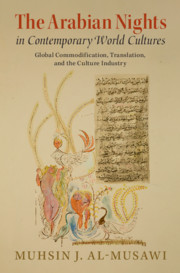 The Arabian Nights in Contemporary World Cultures
The Arabian Nights in Contemporary World Cultures Rewriting the Arabian Nights
Published online by Cambridge University Press: 17 August 2021
Chapter 4 goes along with Borges’s reading of a dynastic translational spectrum of anxieties. A forum for discussion initiated by Galland has been involving a worldwide cultural scene with anxieties that are expressed in reeditions, abridgments, authentication processes, claims to fidelity to an original, though disputed, text, and unexpurgated or collated editions. The discussions erupted since the advent of Galland’s Thousand and One Nights set the scene on fire: accusations and counter charges over three centuries signify the existence of the Nights in world culture as a knowledge consortium that brings on board theories of translation, cultural interventions, and conversations and discussions among the most prominent intellectuals, artists, and fiction writers. Illustrators, film industry producers and directors have been participating in this dynasty, simply because they are part of one translation or another, though on certain occasions they stand on their own. If political dynasties of rulers are often biologically related, the Nights in Europe has its textual dynasty: no translator or editor could ever get free from Galland’s enterprise, not even Muhsin Mahdi who produced Galland’s Arabic manuscript after only portions of it appeared in print early on in the twentieth century. More important is the fact that the Nights was once a platform in the ongoing racial philological divide in language families, Aryan and Semite. New philology found in the Nights a viable means to discuss origins. The divide did not die, and it is reborn in stock images, value judgments, and essentialisms.
To save this book to your Kindle, first ensure [email protected] is added to your Approved Personal Document E-mail List under your Personal Document Settings on the Manage Your Content and Devices page of your Amazon account. Then enter the ‘name’ part of your Kindle email address below. Find out more about saving to your Kindle.
Note you can select to save to either the @free.kindle.com or @kindle.com variations. ‘@free.kindle.com’ emails are free but can only be saved to your device when it is connected to wi-fi. ‘@kindle.com’ emails can be delivered even when you are not connected to wi-fi, but note that service fees apply.
Find out more about the Kindle Personal Document Service.
To save content items to your account, please confirm that you agree to abide by our usage policies. If this is the first time you use this feature, you will be asked to authorise Cambridge Core to connect with your account. Find out more about saving content to Dropbox.
To save content items to your account, please confirm that you agree to abide by our usage policies. If this is the first time you use this feature, you will be asked to authorise Cambridge Core to connect with your account. Find out more about saving content to Google Drive.